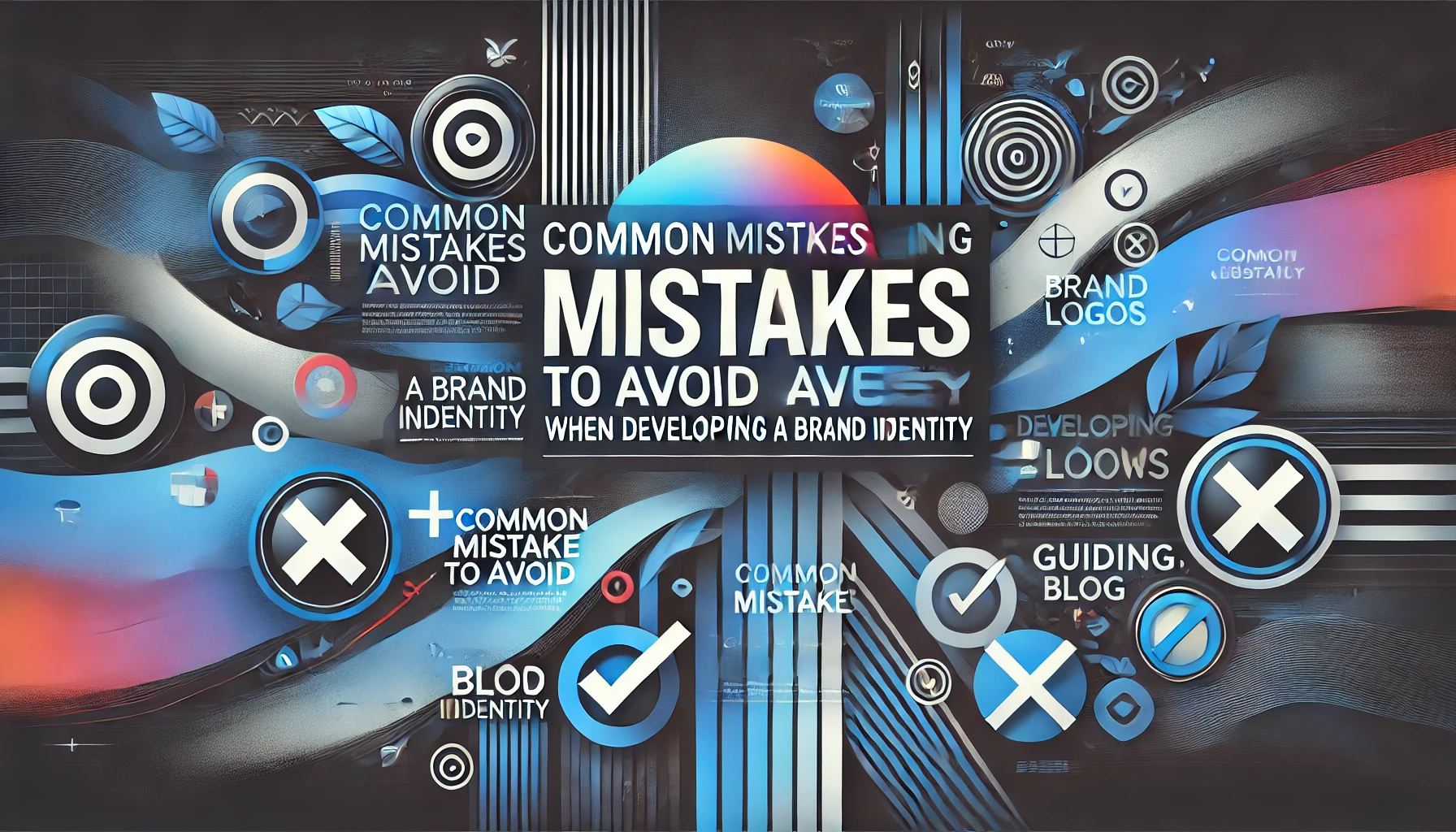Common Mistakes to Avoid When Developing a Brand Identity
Creating a strong brand identity is essential for any business looking to stand out in today’s competitive marketplace. However, many individuals and companies make common mistakes that can hinder their branding efforts. Understanding these pitfalls can help you build a brand that resonates with your audience and stands the test of time. Here are some mistakes to avoid when developing your brand identity.
Neglecting Audience Research
One of the biggest mistakes in brand identity development is failing to understand your target audience. If you don’t know who your customers are, you can’t create a brand that meets their needs. Take the time to research your audience’s preferences, behaviors, and pain points. This knowledge will guide your branding choices, making your brand feel relevant and relatable.
Inconsistency in Brand Messaging
Inconsistency can confuse your audience. If your messaging is different across platforms—such as social media, website, and advertisements—you risk losing credibility. Make sure that your brand voice, tone, and key messages remain consistent. This not only helps build trust but also reinforces your brand identity. Create a style guide to maintain uniformity in all communications.
Overcomplicating the Brand Logo
Your logo is often the first visual representation of your brand that potential customers will see. Overly complex designs can be difficult to recognize and remember. Keep your logo simple, memorable, and versatile. Ensure it works well in various sizes and applications. A well-designed logo will effectively convey your brand’s essence without overwhelming the viewer.
Ignoring the Power of Color
Color plays a crucial role in brand identity. Different colors evoke specific emotions and associations. Failing to choose your color palette wisely could mislead your audience about your brand’s personality. Take the time to research color psychology and select hues that represent your brand values and resonate with your target demographic.
Being Unoriginal
In a saturated market, originality is key. Relying too heavily on trends or imitating competitors can dilute your brand’s uniqueness. Focus on what sets your brand apart and emphasize those qualities. Conduct a thorough market analysis to identify gaps in the market and carve out your niche. Your brand should tell your unique story, reflecting your values and ethos.
Not Defining Brand Values
Your brand values are the foundation of your identity. They guide your decisions and inform your messaging. A common mistake is failing to articulate these values clearly. Take the time to define what your brand stands for. This clarity will help you connect with your audience on a deeper level, aligning your brand with their values and increasing loyalty.
Overlooking Brand Experience
Your brand extends beyond logos and colors—it encompasses the entire customer experience. Each touchpoint, whether it’s interacting with customer service, navigating your website, or engaging with your social media, contributes to your brand perception. Evaluate the customer journey and identify areas for improvement. Consistently delivering exceptional experiences will enhance your brand identity.
Failure to Adapt
The business landscape is always evolving, and so should your brand. Sticking rigidly to your initial branding can render you obsolete. Stay informed about market trends and customer expectations. Be willing to pivot and make adjustments to your brand identity based on feedback and changing dynamics. Adaptability is crucial for long-term success.
Neglecting Digital Presence
In today’s digital age, a strong online presence is crucial. Many brands overlook the importance of optimizing their online platforms—like websites and social media. Ensure your digital presence reflects your brand identity. Optimize your website for user experience and SEO to increase visibility. Social media should also mirror your brand’s voice and values seamlessly.
Avoiding Professional Help
While you may have a strong vision for your brand, developing a brand identity can be complex. Trying to do everything on your own can lead to mistakes that could have been avoided. Consider hiring brand consultants, graphic designers, or marketers for their expertise. Investing in professional help could save you time and resources in the long run.
By steering clear of these common mistakes, you can forge a compelling brand identity that resonates with your audience. Remember, successful branding is not just about aesthetics; it’s about creating meaningful connections. Focus on your audience, stay true to your brand values, and adapt as necessary to develop a lasting identity in the marketplace.
The Importance of Consistency in Brand Messaging
When building a brand, one of the most critical factors to consider is consistency in brand messaging. Consistency helps create a strong identity and fosters trust with your audience. It lets customers know what to expect, makes your brand memorable, and strengthens recognition. However, many businesses make common mistakes that can undermine this essential aspect of brand building.
The first mistake to avoid is neglecting to establish clear brand guidelines. These guidelines should encompass your brand’s tone, voice, and visual identity. Without these, different team members may communicate in varying styles, leading to mixed messages. A unified approach ensures that every piece of content, from social media posts to advertisements, resonates with the same voice. Establishing these rules will save you time and effort in the long run.
Another prevalent mistake is failing to adapt messaging across different platforms. While maintaining a consistent voice is crucial, it’s also important to tailor your message to each specific platform. For example, the tone on LinkedIn may differ from that on Instagram. On LinkedIn, your communication can be more professional, while Instagram may allow for a more relaxed and creative approach. Balancing this allows you to effectively engage your audience, enhancing overall brand perception.
Additionally, ensure that your message aligns with your audience’s expectations. Knowing your target market can make a significant difference in how effectively your brand communicates. For example, a brand targeting young adults should use language that resonates with them. If your messaging feels out of touch, you risk alienating potential customers. Researching your audience and crafting a message that speaks to their needs and preferences is essential.
Another issue to consider is the inconsistency between online and offline messaging. Many brands focus on digital platforms and overlook their traditional marketing methods, such as print materials. All forms of communication should echo the same message. If your website promotes a particular offer, the brochures or flyers you distribute should reflect the same deal. This consistency reinforces your brand identity across multiple channels and strengthens your credibility.
Utilizing a variety of content formats can also lead to inconsistencies if not executed properly. Engaging using videos, blog posts, infographics, and social media updates adds richness to your brand’s messaging. However, the core message should always remain the same, regardless of format. Failing to do so may confuse your audience about what your brand stands for. Keep your messaging clear and straightforward across all formats.
Regularly revising your brand messaging is another common oversight. Brands evolve, and so should your messaging. Yet, some businesses continue to use old slogans or outdated tones long after they’ve shifted in scope. Conduct regular audits on all your messaging, comparing it against your brand values and audience expectations. If discrepancies arise, make the necessary adjustments to remain relevant and engaging.
Ensure you keep your messaging authentic. Customers today value transparency and honesty. If your brand promises something it cannot deliver, or if there’s a disconnect between your messaging and actual experiences, you will lose trust. Authenticity builds customer loyalty. Always ensure that the message you convey reflects your actual brand identity and values.
- Establish Clear Brand Guidelines: Define your tone, voice, and visual identity.
- Adapt Messaging to Platforms: Tailor your voice for LinkedIn versus Instagram.
- Align with Audience Expectations: Use language that resonates with your target market.
- Ensure Online and Offline Consistency: Both mediums should echo the same core messages.
- Utilize Various Formats Effectively: Keep the core message uniform across all content types.
- Regularly Revise Messaging: Audit against brand values to remain relevant.
- Maintain Authenticity: Ensure messaging reflects true brand values and promises.
By avoiding these common mistakes, you can maintain a consistent brand messaging strategy that resonates with your audience. Remember, brand consistency is not just about maintaining a unified look and feel; it’s about creating a lasting impression that fosters trust and loyalty. You want people to think of your brand positively, and that starts with getting your messaging right. Consistent, authentic, and engaging communication will help elevate your brand to new heights.
How Market Research Shapes Your Brand Identity
Every successful brand has a well-defined identity, but crafting that identity isn’t a random act of creativity. Instead, it relies heavily on careful market research. Understanding your target audience, industry trends, and competitive landscape shapes how your brand is perceived and ensures it resonates with your audience. Here’s how market research plays an essential role in developing your brand identity.
Understanding Your Target Audience
Market research enables you to grasp who your target audience is. It helps you identify their demographics, preferences, and behaviors. By knowing your audience, you can craft messages that resonate deeply. This connection can lead to loyalty and trust. Here are ways to gather valuable insights:
- Surveys: Conducting surveys allows you to gather data straight from potential customers. Ask specific questions to unveil what they like or dislike.
- Focus Groups: Engage directly with a group of your target audience. This provides more nuanced insights about their thoughts and feelings.
- Social Media Listening: Monitor what people say about your industry online. Look for trends that could inform your brand’s voice and messaging.
Identifying Industry Trends
Market research also helps you stay updated on industry trends. Knowing what’s current allows you to align your brand identity with evolving consumer expectations. When you adapt to changes in the market, you not only stay relevant but also position your brand as a leader. Here are a few techniques for tracking trends:
- Competitor Analysis: Study your competitors to see what strategies they employ. Look for gaps in their approach that you can fill with your brand identity.
- Industry Reports: Utilize reports to gather insights about market shifts and changing consumer behaviors.
- Online Resources: Use blogs, webinars, and podcasts from industry experts to stay informed on emerging trends.
Defining Your Unique Value Proposition
Your unique value proposition (UVP) differentiates your brand from the competition. Market research helps you identify what makes your brand special. This can be based on quality, pricing, or unique offerings. A clearly defined UVP is critical for positioning your brand. Consider these factors when defining your UVP:
- Customer Pain Points: Understand the problems your target audience faces. Your brand identity should reflect how you solve these issues.
- Brand Personality: Establish a tone that aligns with your audience’s expectations. For instance, a fun, youthful brand may communicate differently than a luxury brand.
- Visual Elements: Develop logos, colors, and fonts that resonate with your UVP. Ensure that your visual identity reflects your brand’s message firmly.
Testing Your Brand Identity
Once you have created an initial brand identity, market research can help you evaluate its effectiveness. Feedback is crucial. Here are methods to test your brand identity:
- A/B Testing: Create two variations of your branding materials and see which one your audience responds to better.
- Customer Feedback: Encourage reviews and feedback on social media and your website. Listen closely to what your audience says.
- Analytics: Use website analytics and social media insights to gauge engagement metrics. High engagement suggests a successful identity.
Adapting and Evolving Your Brand Identity
The market is not static, and neither should your brand identity be. Market research provides ongoing insights that allow for continual adaptation. By monitoring changes in consumer preferences and market conditions, you can refine your brand identity as needed. Staying flexible ensures that your brand remains relevant and appealing to your audience.
Market research is not just a preliminary step but a continuous process that shapes and molds your brand identity. By understanding your audience, identifying trends, and defining your unique value proposition, you lay a solid foundation for a strong and resonant brand. Embrace market research as your strategic partner in building a brand that truly connects with your customers.
Visual Elements That Define Brand Identity
When creating a brand identity, the visual elements you choose are crucial. They help convey your brand’s personality and values to your audience. Understanding these components can significantly strengthen your brand’s position in the market.
Color Palette
Your color palette is one of the first things people notice about your brand. Colors evoke emotions and set the tone for how your audience perceives you. Here are a few tips on selecting the right colors:
- Know your audience: Different demographics may respond to color differently. Ensure the colors resonate with your target market.
- Limit your choices: Stick to a few core colors to maintain brand consistency.
- Test combinations: Some colors can clash. Use tools or templates to see how your colors work together.
Typography
The fonts you choose play a vital role in brand identity. Typography affects readability and can communicate a lot about your brand’s personality. Here’s how to use typography effectively:
- Select purposefully: Choose fonts that match your brand’s tone. Elegant fonts suit luxury brands, while bold ones work for action-oriented businesses.
- Limit font types: Stick to two or three complementary fonts. This practice helps create a unified look.
- Ensure legibility: Your text should be easy to read at all sizes, whether on a website or printed material.
Logo Design
A logo is a visual representation of your brand. It should be unique and memorable while reflecting your brand’s essence. Keep these considerations in mind:
- Keep it simple: A clean, straightforward design is more recognizable.
- Be timeless: Avoid trends that may quickly become outdated. Aim for a design that will last for years.
- Use vector graphics: This ensures your logo remains sharp and clear at any size, whether on a business card or a billboard.
Imagery
The images associated with your brand also matter. Whether you’re using photos or graphics, they should align with your overall brand message. Consider these points:
- Quality matters: Always use high-resolution images. Blurry or pixelated images can make your brand seem unprofessional.
- Consistency is key: Use a similar style of imagery across all platforms, whether it’s sleek, playful, or artistic.
- Relate to your audience: Ensure your imagery resonates with your target market and reflects their aspirations or interests.
Brand Style Guide
A brand style guide is a document that outlines how all visual elements should be used. This guide ensures consistency across all marketing materials. Here’s what to include in your style guide:
- Color specifications: Include exact color codes (e.g., RGB, HEX) for precise replication.
- Font usage: List the fonts, sizes, and styles for headlines, body text, and any other necessary text elements.
- Logo guidelines: Provide instructions on how the logo should appear on different backgrounds, including sizing and spacing.
The visual elements that define your brand identity play a vital role in how your business is perceived. By thoughtfully considering your color palette, typography, logo design, imagery, and the creation of a brand style guide, you ensure a cohesive and strong brand presence. This approach will make your brand more memorable, approachable, and trusted by your audience.
Evolving Your Brand Identity Without Losing Recognition
As businesses grow and evolve, so too must their brand identity. However, changing your brand identity comes with risks. You want your audience to recognize you, yet you also want to refresh and modernize your image. Balancing these two goals can be tricky. Here’s how you can evolve your brand identity without losing recognition.
First, understand what makes your brand recognizable. This includes aspects such as your logo, color scheme, and voice. Take the time to gather feedback from your customers and analyze your existing identity. This will help you pinpoint the elements that are crucial for maintaining recognition. You can achieve this by:
- Conducting Surveys: Reach out to your customers and ask them what they associate with your brand.
- Analyzing Competitors: Look at other brands in your industry for comparisons. Identify what works for them that you might incorporate into your own strategy.
- Reviewing Analytics: Use website and social media analytics to see how your audience interacts with your current brand identity.
Once you have a firm understanding of your recognizable elements, brainstorm ways to modernize while keeping those key identifiers. Here’s how to subtly evolve your brand:
- Refine Your Logo: Instead of a complete overhaul, consider making minor tweaks to your logo. This maintains familiarity while giving it a fresh look.
- Update Your Color Palette: Changing shades in your existing palette can evoke a new feeling without straying too far from your roots.
- Tweak Your Font: A slight revision in typography can modernize your visuals. Just ensure it aligns with your brand’s personality.
It’s also essential to keep your audience engaged during the transition process. People don’t like sudden changes, and by involving them, you can ease the process. Here are strategies to ensure smooth communication:
- Share Your Intent: Explain to your audience why you are evolving your brand identity. Highlight the benefits they can expect.
- Involve Them: Host polls or focus groups to give customers a chance to voice their opinions on the changes.
- Consistent Messaging: Use a unified voice and message across all platforms to create a strong, cohesive identity.
Adaptability is vital in the ever-expanding marketplace. As trends change, so should you, but keep your core values intact. Customers will appreciate that you remain true to your original mission while progressing ahead. To achieve this, consider the following:
- Stay Innovative: Regularly assess market trends and be ready to adapt when necessary.
- Maintain Your Ethos: Remain committed to the values that your brand stands for, ensuring that changes resonate with those principles.
- Be Transparent: Honest communication fosters trust, allowing your audience to feel secure during the evolution.
Visual consistency is also essential in maintaining brand recognition. Ensure that every touchpoint reflects the new identity, from your website to social media platforms. This consistency reassures customers that while the brand may be evolving, it’s still recognizable and trustworthy. Here’s how to achieve visual consistency:
- Brand Guidelines: Create a detailed document outlining how your brand elements should be used across all media, from digital to print.
- Regular Audits: Conduct audits of your online and offline presence to ensure everything is aligned with the new brand identity.
- Training Employees: Make sure that your team understands the new brand identity, so they can communicate it effectively to your audience.
Ultimately, evolving your brand identity doesn’t mean abandoning what you’ve built; it’s about refining and reintroducing yourself to the world. Engage your audience, embrace your history, and incorporate modern elements that reflect contemporary values. This balance will ensure you remain recognizable while appealing to both existing and new customers.
Conclusion
Building a strong brand identity is a multifaceted process that requires careful consideration and a strategic approach. Recognizing common mistakes can save you time, effort, and resources in the long run. One of the most critical aspects discussed is the importance of consistency in brand messaging. When your messaging aligns across all platforms, it strengthens recognition and builds trust among your audience.
Understanding your target market through thorough research is not just a step in development; it’s the backbone of your brand identity. Insights gained can directly shape how you position your brand, ensuring it resonates with potential customers. Additionally, visual elements like logos, color schemes, and typography play a vital role in creating an immediate emotional response. Investing time in these visuals can set the tone for your entire brand experience.
Remember that brand identity should evolve over time. As your audience’s needs and preferences change, so too can your brand. The key is to adapt without losing the essence that people recognize and love. This delicate balance ensures you remain relevant and connected to your audience. By avoiding these common pitfalls, applying diligent research, maintaining consistency, and being open to evolution, you set the stage for a memorable brand identity that truly stands out. Engaging with your audience and refining your identity will lead to a strong, lasting impression in a competitive market.




